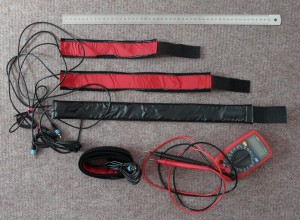 I have collected many objectives (OTAs – optical tube assemblies) during the last three years I have been doing astronomical photography and since I decided to have a heating strap for every single lens I use (so as I do not have to take them off, put on, forget at home and so on) it happened that I gathered about 11 various heating straps. Now the question comes – what is the resistance, power consumption and current draw (at 12V) of every particular heating strap? As I have few duplicates the following table shows measured values for 9 remaining straps of different size (length):
I have collected many objectives (OTAs – optical tube assemblies) during the last three years I have been doing astronomical photography and since I decided to have a heating strap for every single lens I use (so as I do not have to take them off, put on, forget at home and so on) it happened that I gathered about 11 various heating straps. Now the question comes – what is the resistance, power consumption and current draw (at 12V) of every particular heating strap? As I have few duplicates the following table shows measured values for 9 remaining straps of different size (length):
| Manufacturer | Product Name | R [Ω] | P12V [Watt] | I12V [A] |
|---|---|---|---|---|
| AstroZap | AstroStrap Dew Heater for 1.25″ Eyepieces | 56,3 | 2,56 | 0,21 |
| AstroZap | AstroStrap Dew Heater for 2″ Eyepieces | 45,2 | 3,19 | 0,27 |
| AstroZap | AstroStrap Dew Heater for 3″ Telescopes | 26,4 | 5,45 | 0,45 |
| AstroZap | AstroStrap Dew Heater for 4″ Telescopes | 20,3 | 7,09 | 0,59 |
| AstroZap | AstroStrap Dew Heater for 5″ Telescopes | 18,7 | 7,7 | 0,64 |
| AstroZap | AstroStrap Dew Heater for 11″ Telescopes | 9,3 | 15,48 | 1,29 |
| DewNot | Dew Not Heizmanschette 2″ (DN22/DN003) | 39,8 | 3,62 | 0,3 |
| DewNot | Dew Not Heizmanschette 3″ (DN33/DN004) | 26,9 | 5,35 | 0,45 |
| DewNot | Dew Not Heizmanschette 7″ (DN64/DN008) | 14,4 | 10 | 0,83 |
Notice that 3″ dew strap from two different manufacturers (AstroZap and Dew Not) have almost identical resistance and thus power consumption and current draw. The longer strap the smaller resistance and bigger power consumption and current draw.
As I live at a very humid place I heat with 12 Volts (full power) during whole night to keep my refractors dry (my SCT uses also a dew cap). There’s nothing like having a clean and dry objective in order to capture high quality data (dew causes gradients and problems with flat field calibration because of lower signal). Once it happened that even with 12V heating my 6″ refractor (heating power 10 Watts) was not sufficient on a very humid night when imaging around zenith for over 3 hours. Keep your optics warm!
